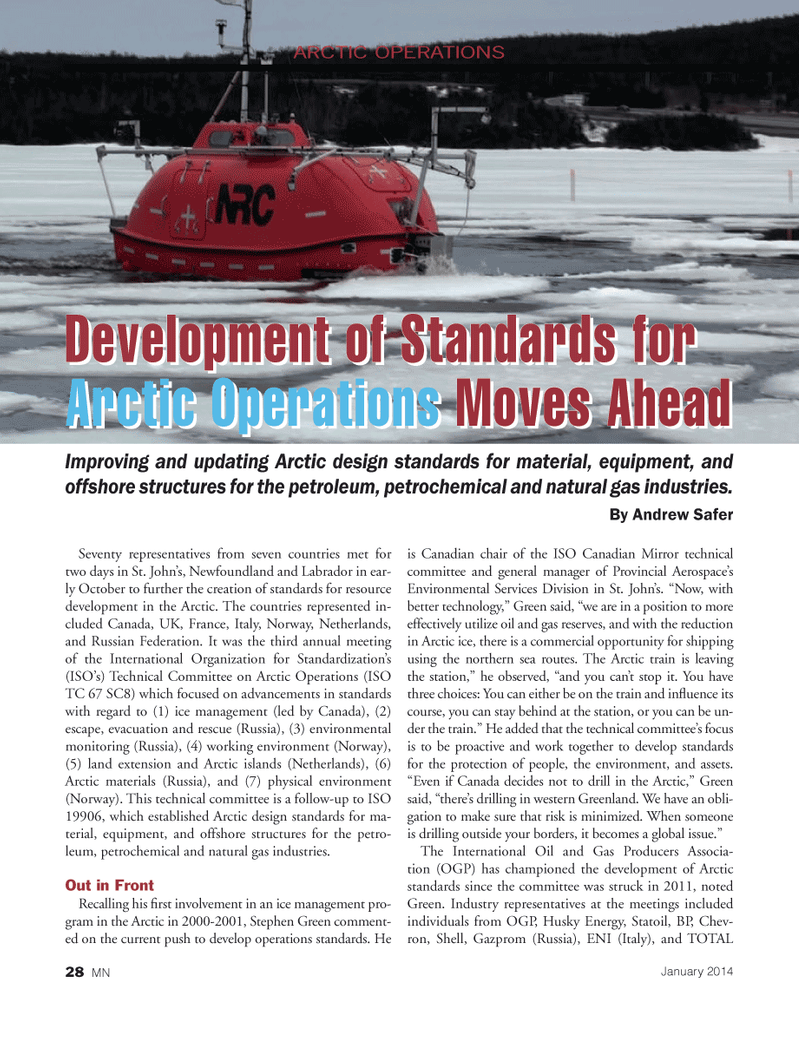
Page 28: of Marine News Magazine (January 2014)
Tug Boat Technology
Read this page in Pdf, Flash or Html5 edition of January 2014 Marine News Magazine
Seventy representatives from seven countries met for two days in St. John’s, Newfoundland and Labrador in ear- ly October to further the creation of standards for resource development in the Arctic. The countries represented in- cluded Canada, UK, France, Italy, Norway, Netherlands, and Russian Federation. It was the third annual meeting of the International Organization for Standardization’s (ISO’s) Technical Committee on Arctic Operations (ISO
TC 67 SC8) which focused on advancements in standards with regard to (1) ice management (led by Canada), (2) escape, evacuation and rescue (Russia), (3) environmental monitoring (Russia), (4) working environment (Norway), (5) land extension and Arctic islands (Netherlands), (6)
Arctic materials (Russia), and (7) physical environment (Norway). This technical committee is a follow-up to ISO 19906, which established Arctic design standards for ma- terial, equipment, and offshore structures for the petro- leum, petrochemical and natural gas industries.
Out in Front
Recalling his fi rst involvement in an ice management pro- gram in the Arctic in 2000-2001, Stephen Green comment- ed on the current push to develop operations standards. He is Canadian chair of the ISO Canadian Mirror technical committee and general manager of Provincial Aerospace’s
Environmental Services Division in St. John’s. “Now, with better technology,” Green said, “we are in a position to more effectively utilize oil and gas reserves, and with the reduction in Arctic ice, there is a commercial opportunity for shipping using the northern sea routes. The Arctic train is leaving the station,” he observed, “and you can’t stop it. You have three choices: You can either be on the train and infl uence its course, you can stay behind at the station, or you can be un- der the train.” He added that the technical committee’s focus is to be proactive and work together to develop standards for the protection of people, the environment, and assets. “Even if Canada decides not to drill in the Arctic,” Green said, “there’s drilling in western Greenland. We have an obli- gation to make sure that risk is minimized. When someone is drilling outside your borders, it becomes a global issue.”
The International Oil and Gas Producers Associa- tion (OGP) has championed the development of Arctic standards since the committee was struck in 2011, noted
Green. Industry representatives at the meetings included individuals from OGP, Husky Energy, Statoil, BP, Chev- ron, Shell, Gazprom (Russia), ENI (Italy), and TOTAL
ARCTIC OPERATIONS
Development of Standards for
Arctic Operations Moves Ahead
Development of Standards for
Arctic Operations Moves AheadMoves Ahead
Improving and updating Arctic design standards for material, equipment, and offshore structures for the petroleum, petrochemical and natural gas industries.
By Andrew Safer
January 2014 28 MN
MN JAN14 Layout 18-31.indd 28 12/20/2013 10:07:49 AM

 27
27

 29
29
